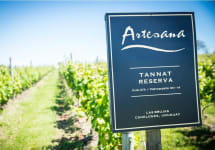Artesana Tannat Reserva 2020
-
James
Suckling -
Wine
Enthusiast



Product Details
Your Rating
Somm Note
Winemaker Notes
Full bodied and redolent with rich cassis and blackberry fruit with layers of licorice, clove, cedar and allspice harmonizing in a long and well rounded finish.
Pairs beautifully with pasta and meat dishes including beef, lamb and pork.
Professional Ratings
-
James Suckling
Notes of dark fruit, mulberries, cloves, charcoal and toasted oak. It’s full-bodied with sinewy tannins. Dark, tarry and meaty, yet fresh. Good length.
-
Wine Enthusiast
Rich berry flavors are nicely blended with vanilla on the well-structured palate. This wine is full-bodied and has smooth tannins and enough acidity to lift the concentrated flavors. It has an enjoyable medium finish.
Other Vintages
2019-
James
Suckling
-
James
Suckling -
Wine
Enthusiast



Artesana is a small production, single vineyard estate winery located in the acclaimed Canelones winegrowing region of Uruguay. Made with the highest quality estate-grown fruit, Artesana’s iconic wines showcase Uruguay’s distinctive terroir and its signature varietal Tannat.
Uruguay produces dynamic and award-winning wines of outstanding quality. Differing from Argentina and Chile, Uruguay is a country of smallscale, family-owned wineries with a European winemaking tradition. The coastal Atlantic climate is often compared to Bordeaux’s, producing wines with well-balanced levels of alcohol and acidity. Tannat, brought from France in the 1870s, produces rich, full-bodied red wines with dark fruit and spice aromas and flavors.
Artesana was developed in 2007 by American Blake Heinemann who recognized the unique character of Uruguay’s Tannat wines and thought others would be interested in discovering them as well. “Uruguay is an extraordinary country. When I first tasted the Tannat wines from the Canelones region I was struck by their richness. Uruguay is being recognized as a fine wine producer and deservedly so. There are excellent wines being made in Uruguay and Tannat is a very distinctive grape. It has an exotic spicy character that can be big and bold, yet elegant and complex.”
Artesana’s award-winning winemakers Analía Lazaneo and Valentina Gatti share the passion of handcrafting wines that express the unique terroir of Artesana’s Las Brujas vineyard. They have an intimate knowledge of the macro terroir of the Canelones region and the intricacies of the Tannat grape, and represent the next generation of Uruguayan winemakers.

Named for its naturally high level of tannins, Tannat is a brooding, rustic, dark red wine that sees its origin in the Madiran region of France. Similar to Malbec’s journey to Argentina from France, Tannat made a similar move in the early 19th century but landed in Uruguay in the hands of Basque settlers. Today Tannat thrives in its warm South American climate, producing a bold, black fruit driven red. Somm Secret—Uruguay producers have the freedom to blend firm Tannat with any other grape whereas Madiran law restricts Tannat’s blending grapes to Cabernet Sauvignon, Cabernet Franc and the indigenous grape, Fer.

Considered one of the most environmentally sustainable countries in the world, Uruguay is also the fourth largest wine producing country in South America. But in contrast to its neighbors (Chile, Argentina and even Brazil) Uruguay keeps more in step with its European progenitors where land small holdings are most common. Most Uruguayan farms are tiny (averaging only about five hectares) and family-run, many dating back multiple generations. At this size, growers either make small amounts of wine for local consumption or sell grapes to a nearby winery. In all of Uruguay there are close to 3,500 growers but fewer than 300 wineries.
On these small plots of land, manual tending and harvesting, as well as low yields are favored; this small agricultural country has never had a need for large-scale chemical fertilizers or insecticides. Their thriving meat industry also follows the same standards: hormones have been banned since 1968 and today all Uruguayan beef is organic and grass-fed.
Uruguay’s best vineyards are on the Atlantic coast, in Canelones and Maldonado (where cooling breezes lessen humidity) or found hugging its border with Argentina. With a climate similar to Bordeaux and soils clay-rich and calcareous, Uruguay is perfect for Tannat, a thick-skinned, red variety native to Southwest, France. A great Tannat from Uruguay will have no lack of rich red and black fruit, lots of sweet spice and a hefty structure. Sometimes winemakers blend Merlot or Pinot noir with Tannat to soften up its rough edges.
The best Uruguayan whites include Sauvignon blanc and Albarino.
